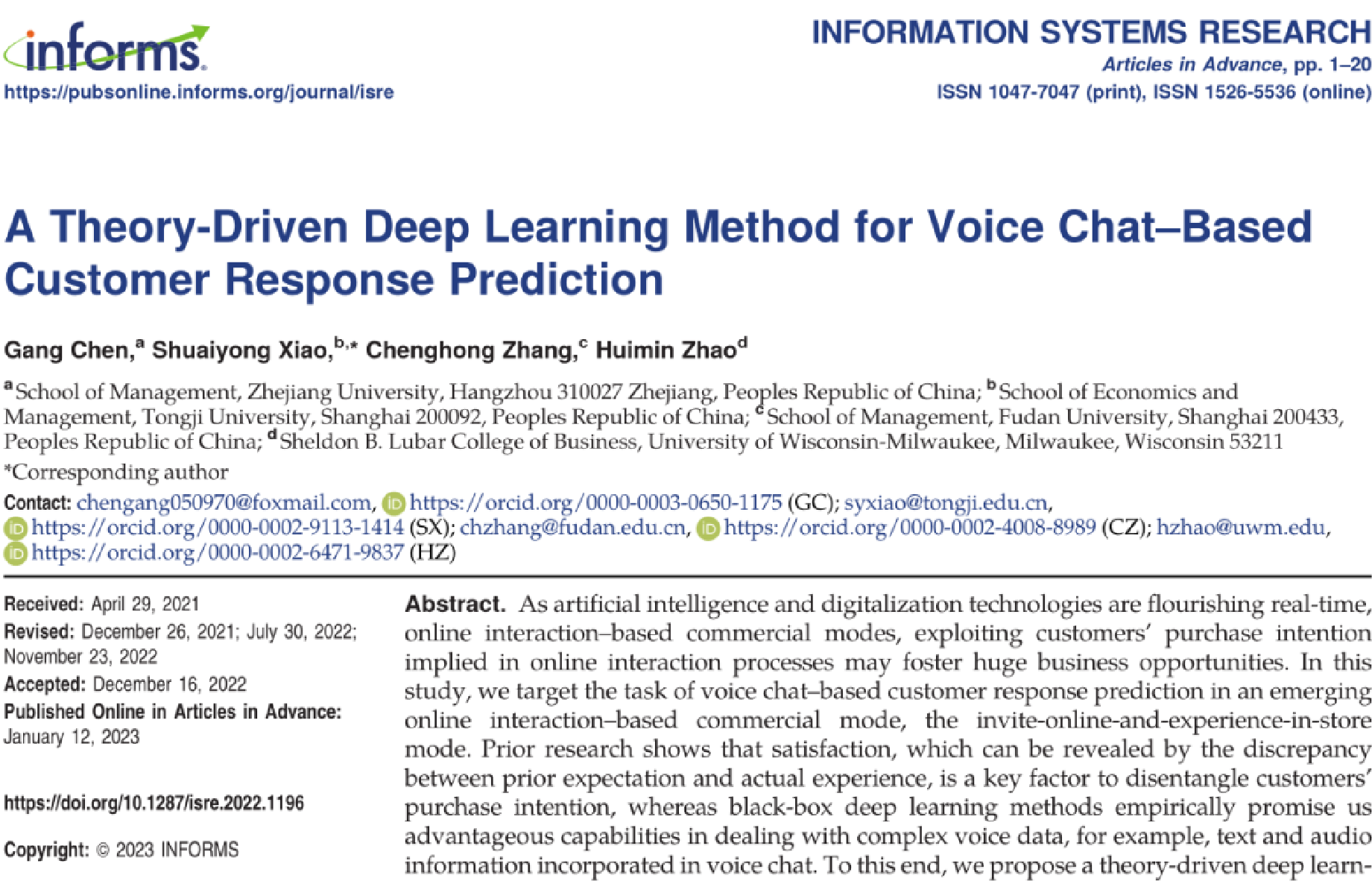When it comes to customer service staff and sales, the general perception is that it can be challenging to deal with. Whether it’s real estate agents or car salespersons, they often bombard you with phone calls. Online customer service interactions often involve repetitive use of the term "dear" without actually addressing the core issues at hand.
This kind of dialogue not only frustrates consumers but also poses a significant challenge for merchants. Even with the recruitment and proper training of customer service staff, many merchants struggle to retain customers. The impersonal nature of online communication, whether through screens or telephones, fails to evoke the desired consumer purchasing impulse.
Imagine the convenience if we could gather consumers’ information, understand their shopping preferences, and even influence their purchase decisions through just a few online dialogues. This is a common desire among merchants, as it not only improves efficiency but also significantly reduces costs.
Fortunately, this wish can now be fulfilled!

|
©千库网 | Qianku Network |
CHEN Gang, a Distinguished Associate Research Fellow in the Department of Data Science and Engineering Management at the School of Management, Zhejiang University, and his team have dedicated their attention to addressing various challenges in voice customer service dialogues. Their latest scientific research achievements offer promising solutions to help merchants overcome difficulties and achieve their desired outcomes.
Recently, CHEN Gang and his team published their research findings titled "A Theory-driven Deep Learning Method for Voice-chat-based Customer Response Prediction" in the prestigious international journal, Information Systems Research (one of the UTD24 journals).
Their research focuses on the "online voice customer invitation dialogue scenario" and presents a comprehensive model that enables merchants to gain a deeper understanding of consumers’ preferences and purchase intentions. This valuable insight provides an important reference value for enhancing customers’ purchase conversion rates, ultimately leading to improved business performance.

|
You can access the original research paper here |
|
CHEN Gang | 陈刚 School of Management, Zhejiang University |
||
|
|
||
|
|
|
Academic Background: Distinguished Associate Research Fellow, Department of Data Science and Engineering Management, School of Management, Zhejiang University. His research interests are multimodal business data analysis, deep learning and explainable artificial intelligence. You can learn more about CHEN Gang’s academic background here |
|
Successful prediction rates up to 80% ~ 90% What exactly can this model do? |
In daily consumption scenarios, "online dialogue" serves as a common sales channel. Telemarketing (voice dialogue) and online customer service (text dialogue) are two types of real-time online interactive business models that we encounter regularly.
With the rapid advancement of artificial intelligence and digital technology, this business model has gained significant prominence in the platform economy. It has become an essential means for enterprises to comprehend customer needs, identify customer values, and provide customer services.
Customer service staff engage in various activities such as inquiring about customers’ purchase intentions, actively introducing products, inviting customers to experience in-store purchases, and addressing customer complaints and concerns. Through these interactions, they are able to gather substantial customer information during the "online dialogue," which possesses tremendous commercial value.
However, CHEN Gang and his team have devoted their attention to numerous challenges surrounding the mining of customers’ needs and preferences based on the content of online invitation dialogues. In their latest scientific research, they successfully tackled these challenges one by one through advanced modeling techniques.
|
① |
This model can make customer service staff "draw inferences" |
|
In the online invitation scenario, it is challenging for enterprises or customer service staff to obtain sufficient customer information during the pre-sales stage. It is also impossible to anticipate customer needs and expectations in advance. Therefore, customer service staff must rely solely on dialogue to capture users’ evolving needs and preferences. Many customer service staff members can make informed inferences using the model developed by CHEN Gang and his team. Currently, many merchants’ customer service staff follow the practice of initially making a phone call and then continuously following up with customers throughout the subsequent process. However, this approach not only risks alienating customers but also represents a significant waste of merchants’ sunk costs. Fortunately, with the latest model developed by the scientific research team, it becomes possible to infer customers’ preferences for product attributes through a single phone call. This capability allows for the capture of customers’ personalized and dynamic preferences, leading to more effective and efficient customer interactions. |
|
② |
Help customer service staff to effectively adjust the strategy during the dialogue |
|
As customers’ dialogue experience and product expectations dynamically evolve during the interaction, modeling customers’ dialogue experience by leveraging audio information, semantic information, and the interactive mode inherent in voice dialogues becomes a focal point for CHEN Gang and his team. During a phone call or an online dialogue, customers’ purchase intentions continuously adapt. By assessing which product attributes customers express satisfaction or dissatisfaction with through the dialogue, customer service staff can effectively align their efforts and adjust their sales strategies accordingly. This valuable insight enables them to focus their attention in the right direction and provide tailored recommendations to enhance the overall customer experience. |
|
③ |
Unification of explainability and predictive ability of deep learning model |
|
The dynamic nature of online dialogues, coupled with the uncertainty of dialogue content, poses a technical challenge when it comes to accurately assessing customers’ purchase intentions and their changing trends based on the dialogue content. CHEN Gang and his team’s model successfully address this challenge by providing a technical solution. Their innovative approach incorporates both text and sound, allowing for the modeling of customers’ purchase intentions based on their personalized preferences and dialogue experience. This groundbreaking methodology contributes to greater transparency in customers’ purchase decisions, enabling businesses to better understand and cater to their customers’ needs. |
|
They Found That This Model Can Make Consumers’ Intentions and Behaviors More "Transparent" |
When considering purchasing a car, it is common to engage in dialogue with salespersons from various brands simultaneously. During this process, you may find that certain salespersons provide a more comfortable and informative dialogue experience. As a result, you may prioritize visiting the corresponding dealership for further exploration, even if that brand was not initially your first choice. This shift occurs because the principle of "experience surpassing expectations" takes precedence.
The underlying principle behind this phenomenon, where consumers alter their purchase decisions due to the "discrepancy between prior expectations and actual experiences," is known as "inconsistency with expectations."

|
©千库网 | Qianku Network |
Building upon the theory of "inconsistency with expectation," CHEN Gang and his team have developed a voice dialogue data model called the "customer service staff - customer" model. This comprehensive model consists of three sub-models: the dynamic expectation model, the customer experience model, and the "expectation-experience" comparison model.
By utilizing this model, the dynamic needs and preferences of customers are unveiled through the analysis of the contrast between their expectations and actual experiences. This enables the explanation and prediction of customers’ purchase intentions.
With the implementation of this model, enterprises can enhance their customer conversion rates by effectively and accurately analyzing customers’ psychological trends and consumption desires. As a result, this model brings significant commercial value to enterprises, empowering them to better meet the needs of their customers and drive business success.
|
① |
Making customer preferences and purchase decisions "analyzable" |
|
In this study, CHEN Gang and his team have successfully integrated the theory of inconsistency with expectation into the deep modeling of customers’ purchase intentions based on voice dialogue data. By utilizing a sample dialogue scenario, they have significantly enhanced the accuracy of "customer purchase intention prediction based on dialogue." This model not only enables merchants to understand why consumers ultimately choose or decline to purchase their products, but also helps them gain a deeper understanding of customer preference attributes. This valuable insight can be translated into actionable insights that drive consumer consumption and generate greater profits for businesses. Furthermore, this research demonstrates that incorporating the theoretical mechanism of explainability into the deep learning modeling process effectively improves the prediction capabilities of deep learning models. |
|
② |
Accurately predicting the changing trend of customer intention |
|
In the context of the "customer service staff - customer dialogue" scenario, CHEN Gang and his team have established that customers’ purchase intentions undergo dynamic changes, and their cumulative purchase intentions exhibit an approximately monotonic trend. Every word uttered by consumers during the dialogue can potentially reflect a "shopping intention." Through the developed model, it becomes possible to predict consumers’ intentions in real time throughout the dialogue. This enables customer service staff to receive timely reminders and make necessary adjustments based on customers’ emotional inflection points. By leveraging this predictive capability, customer service staff can effectively adapt their responses and actions to better cater to customers’ evolving needs and enhance the overall customer experience. |

|
Figure 4 | Dynamic Customer Purchase Intention Modeling Results Based on Dialogue |
|
This finding validates that enterprises can effectively predict the evolving trends of customers’ intentions during dialogues using the deep learning method developed in this study. It allows them to identify customers who may be inclined towards leaving or not making a purchase before the conclusion of the dialogue. By leveraging this predictive ability, enterprises can proactively adapt their speech skills and engagement strategies to improve the customer conversion rate. |
|
③ |
Make consumer behavior be "explainable" |
|
The deep learning model developed in this study for predicting customer purchase intentions is characterized by its explainability. This means that it enables merchants not only to understand consumers’ preferences but also to analyze the underlying factors influencing their consumption decisions. Through training, the model can infer customers’ personalized preferences and experiences based on a collection of example customer samples. This valuable insight provides powerful guidance for various aspects, such as follow-up customer service training and product improvement. By gaining a deeper understanding of customers’ preferences and experiences, merchants can tailor their customer service interactions, refine their product offerings, and enhance overall customer satisfaction. This explainable model serves as a valuable tool in assisting businesses in making informed decisions and delivering a more personalized and impactful customer experience. |

|
©千库网 | Qianku Network |
|
This Model Not Only Opens Up a New Theoretical Perspective, But Also Becomes the "Wealth Code" of the Enterprises |
Improving customer satisfaction, increasing consumer purchase rates online, and enhancing repurchase rates are indeed critical areas that warrant continuous attention from enterprises and merchants.
The findings of CHEN Gang and his team hold immense importance, as they contribute not only to academic theory but also to the practical business value for enterprises. The discoveries made by the team can be regarded as a "wealth code" for enterprises, enabling them to unlock and harness the true value of their customers.
|
Theoretical Contribution |
ChatGPT — The construction of this explainable deep learning model and its application in business prediction scenarios opens up a new paradigm in design science modeling. It organically integrates consumer behavior theory with the deep learning modeling process, providing effective decision support for users to comprehend the learning process and prediction results of deep learning models.
Additionally, the research conducted by CHEN Gang and his team introduces a new methodological perspective on achieving the unity of predictive performance and explainable performance in deep models. The modeling strategy proposed in this study not only achieves the internal unity of predictive performance and interpretability, but also offers an efficient method and tool for extracting user preferences and needs from multi-modal business dialogue data, including text and voice dialogues between customers and customer service staff.

|
©千库网 | Qianku Network |
|
■ |
Commercial Value |
Enterprises can secure customer resources by offering high-quality personalized services, thereby enhancing the customer purchase conversion rate and gaining a first-mover advantage in the competitive market. However, achieving this requires enterprises to accurately capture customer intentions through invitation dialogue content, thoroughly understand customer needs, and have knowledge of customers’ preferences during pre-sales interactions with customer service staff.
|
① |
Intelligent real-time speech skill support tool for enterprises |
|
As the dialogue between customer service staff and customers progresses, CHEN Gang and his team’s model can provide real-time updates on the cumulative satisfaction of customers during the ongoing dialogue. It can also infer the current demand and satisfaction of customers regarding key product attributes in real time. This capability allows enterprises to continuously assess and address customer needs, ensuring a more satisfactory and personalized customer experience. This provides real-time decision support for customer service staff to adjust their speech skills in time, correctly adapt to customer interests and reasonably respond to customer concerns. |

|
©千库网 | Qianku Network |
|
② |
Efficient business dialogue quality inspection tool |
|
This model not only enhances the efficiency of customer service staff but also enables customer service managers to save time and conduct quality inspections more effectively, influencing their consumption decisions. When each historical dialogue is inputted into the model, it provides real-time predictive indicators of customer satisfaction and corresponding explanations for the dialogue. For instance, it identifies specific issues (related to product attributes) that the customer is dissatisfied with during a particular conversation, or instances where the customer service staff fails to effectively address the customer’s concerns. By utilizing this process, customer service managers can accurately and efficiently identify high-quality and low-quality customer service dialogues. |
|
③ |
Provide ideas for new product design and development |
|
Under uncertain circumstances, the new model has the capability to extract key marketing information, including customer preferences and needs, solely through customer service staff-customer dialogues. This information can offer valuable decision support for managers, enabling them to enhance new product design and improve marketing efficiency. |
- We applaud CHEN Gang and his dedicated team for their remarkable achievements, and we anticipate that the era of smarter dialogues will usher in a new era of prosperity and convenience for all involved.
- You can read the original article in Chinese here